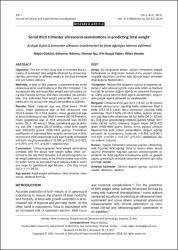| dc.contributor.author | Güdücü, Nilgün | |
| dc.contributor.author | Gönenç, Gökçenur | |
| dc.contributor.author | İşçi, Herman | |
| dc.contributor.author | Başgül Yiğiter, Alin | |
| dc.contributor.author | Dünder, İlkkan | |
| dc.date.accessioned | 2015-02-03T10:41:14Z | |
| dc.date.available | 2015-02-03T10:41:14Z | |
| dc.date.issued | 2013 | |
| dc.identifier.citation | Guducu N, Gonenc G, Isci H, Basgul Yigiter A, Dunder I. Serial third trimester ultrasound examinations in predicting fetal weight.Journal of Clinical and Experimental Investigations. 2013; 4(1): 28-33. doi: 10.5799/ahinjs.01.2013.01.0229 | en_US |
| dc.identifier.issn | 1309-8578 | |
| dc.identifier.uri | http://www.jceionline.org/dl.php?yayin_id=291&dil=tr&filename=upload/sayi/16/JCEI-00409.pdf | en_US |
| dc.identifier.uri | https://hdl.handle.net/11446/682 | en_US |
| dc.description | İstanbul Bilim Üniversitesi, Tıp Fakültesi. | en_US |
| dc.description.abstract | OBJECTIVES:
To construct a clinical management matrix using serial fetal abdominal circumference measurements (ACMs) that will predict normal birth weight in pregnancies complicated by gestational diabetes (GDM) and reduce unnecessary ultrasound examination in women with GDM.
STUDY DESIGN:
Retrospective cohort study of 144 women with GDM in a specialist obstetric-diabetes clinic. Women with GDM who delivered singleton infants were identified from a clinical register. Regression analysis was used to identify associations between serial ACMs, maternal parameters and normal birth weight (birth weight between the 10th and 90th percentiles). Predictive clinical models were designed with the aim of identifying normal birth weight infants with the lowest number of fetal ultrasound scans.
RESULTS:
Compared to mothers of large-for-gestational-age (LGA) infants, mothers of normal weight infants had lower fasting glucose measurements at diagnosis (5.9 mmol/l±1.0 vs. 6.6 mmol/l±0.7, p<0.05), lower maternal weight at delivery (90 kg±17 vs. 96 kg±17, p<0.05), and a lower rate of prior LGA infants (31% vs. 60%, p<0.05). Maternal weight and a history of prior LGA delivery were identified as useful predictors of fetalbirth weight in predictive models. Serial ACMs below the 50th, 75th and 90th percentiles could predict normal birth weight with 100%, 97% and 96% positive predictive value respectively when used in these risk factor based models. Two measurements sufficed in low-risk pregnancies.
CONCLUSION:
Serial ACMs can predict normal birth weight in GDM. | en_US |
| dc.language.iso | eng | en_US |
| dc.publisher | Association of Health Investigations | en_US |
| dc.rights | info:eu-repo/semantics/openAccess | en_US |
| dc.subject | fetal weight estimation | en_US |
| dc.subject | third trimester ultrasound | en_US |
| dc.subject | hadlock formula | en_US |
| dc.subject | tahmini doğum ağırlığı | en_US |
| dc.subject | üçüncü trimester ultrasonu | en_US |
| dc.subject | hadlock | en_US |
| dc.title | Serial third trimester ultrasound examinations in predicting fetal weight | en_US |
| dc.title.alternative | Ardışık üçüncü trimester ultrason incelemeleri ile fetal ağırlığın tahmin edilmesi | en_US |
| dc.type | article | en_US |
| dc.relation.journal | Journal of Clinical and Experimental Investigations | en_US |
| dc.department | DBÜ, Tıp Fakültesi | en_US |
| dc.identifier.issue | 1 | |
| dc.identifier.volume | 4 | |
| dc.identifier.startpage | 28 | |
| dc.identifier.endpage | 33 | |
| dc.contributor.authorID | TR123126 | en_US |
| dc.contributor.authorID | TR141251 | en_US |
| dc.contributor.authorID | TR123093 | en_US |
| dc.contributor.authorID | TR122849 | en_US |
| dc.contributor.authorID | TR26039 | en_US |
| dc.relation.publicationcategory | Belirsiz | en_US |


















